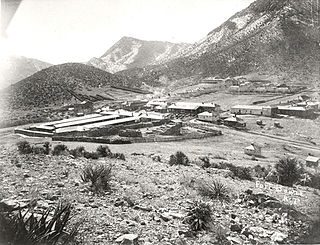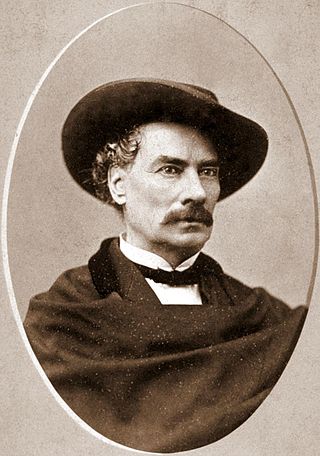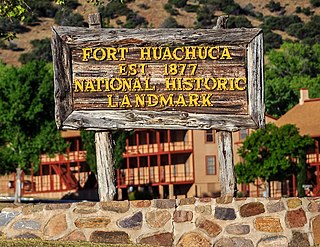
The Apache Wars were a series of armed conflicts between the United States Army and various Apache tribal confederations fought in the southwest between 1849 and 1886, though minor hostilities continued until as late as 1924. After the Mexican–American War in 1846, the United States annexed conflicted territory from Mexico which was the home of both settlers and Apache tribes. Conflicts continued as American settlers came into traditional Apache lands to raise livestock and crops and to mine minerals.

The Battle of Apache Pass was fought in 1862 at Apache Pass, Arizona, in the United States, between Apache warriors and the Union volunteers of the California Column as it marched from California to capture Confederate Arizona and to reinforce New Mexico's Union army. It was one of the largest battles between the Americans and the Chiricahua during the Apache Wars.

The 1st Cavalry Regiment is a United States Army regiment that has its antecedents in the early 19th century in the formation of the United States Regiment of Dragoons. To this day, the unit's special designation is "First Regiment of Dragoons". While they were the First Regiment of Dragoons, another unit designated the 1st Cavalry Regiment was formed in 1855 and in 1861 was re-designated the 4th Cavalry Regiment. The First Dragoons became the 1st Cavalry Regiment, since they were the oldest mounted regiment.

Apache Pass, also known by its earlier Spanish name Puerto del Dado, is a historic mountain pass in the U.S. state of Arizona between the Dos Cabezas Mountains and Chiricahua Mountains at an elevation of 5,110 feet (1,560 m). It is approximately 20 miles (32 km) east-southeast of Willcox, Arizona, in Cochise County.

The California Column was a force of Union volunteers sent to Arizona and New Mexico during the American Civil War. The command marched over 900 miles (1,400 km) from California through Arizona and New Mexico Territory to the Rio Grande and as far east as El Paso, Texas, between April and August 1862.

Fort Bowie was a 19th-century outpost of the United States Army located in southeastern Arizona near the present day town of Willcox, Arizona. The remaining buildings and site are now protected as Fort Bowie National Historic Site.

Antonio María de la Guerra was a Californio politician and military officer, who served in the California Senate and twice as Mayor of Santa Barbara. He also commanded the 1st California Cavalry Battalion during the Civil War and later served several terms on the Santa Barbara County Board of Supervisors.

Major John C. Cremony was an American soldier who wrote the first dictionary of the Apache language and later became a newspaperman in San Francisco.

The 1st Battalion of Native Cavalry, California Volunteers was a cavalry battalion in the Union Army during the American Civil War. Recruits were largely drawn from the Californio population, though its ranks included Yaqui and Mission Indians as well as immigrants from Mexico, Hispano America and Europe. In addition to its ethnic makeup, the Battalion is also considered unusual for being one of the few lancer units in the United States Army.

The 7th California Infantry Regiment was an infantry regiment in the Union Army during the American Civil War. It spent its entire term of service in the western United States, attached to the Department of the Pacific, serving in California and Arizona Territory. They were known as the "Gold Diggers" in reference to the large number of recruits from the California's "Mother Lode" region. Later, they were also called the "Hungry Seventh" for the privations they suffered in Arizona, particularly at Fort Mason and took part in the Battle of Chiricahua Mountains. The Regiment included many veterans of the Mexican–American War.
Edwin L. Elwood was an American soldier in the U.S. Army who served with the 8th U.S. Cavalry during the Indian Wars. He took part in campaigns against Cochise and the Apache Indians in the Arizona Territory in the late-1860s and was one of thirty-two men received the Medal of Honor for gallantry during the fighting in the Chiricahua Mountains, known as the "Campaign of the Rocky Mesa", on October 20, 1869.
Sergeant Frederick Jarvis was an American soldier in the United States Army who served with the 1st U.S. Cavalry regiment during the Apache Wars. He was one of thirty-two men received the Medal of Honor for gallantry fighting Cochise and the Apache Indians in the Chiricahua Mountains of Arizona, known as the "Campaign of the Rocky Mesa", on October 20, 1869.
Private John Tracy, born Henry G. Nabers, was an Irish-born soldier in the U.S. Army who served with the 8th U.S. Cavalry during the Apache Wars. He was one of thirty-two men received the Medal of Honor for gallantry in fighting Cochise and the Apache Indians in the Chiricahua Mountains of Arizona, later known as the "Campaign of the Rocky Mesa", on October 20, 1869.
James Sumner was a United States Army soldier and a recipient of the United States military's highest decoration, the Medal of Honor, for his actions in the Indian Wars of the western United States. An English immigrant, Sumner served as a cavalryman during the Apache Wars of southeastern Arizona Territory. He was awarded the Medal of Honor for advancing through heavy fire in a skirmish against a group of Chiricahua Indians led by Cochise.

The Battle of Fort Buchanan was an Apache attack on the United States Army post of Old Fort Buchanan in southern Arizona Territory, which occurred on February 17, 1865. Though a skirmish, it ended with a significant Apache victory when they forced the small garrison of California Volunteers to retreat to the Santa Rita Mountains. Fort Buchanan was the only American military post conquered during the war against the Chiricahua.
Private Christian Steiner was a German-born American soldier in the U.S. Army who served as a saddler with the 8th U.S. Cavalry during the Apache Wars in the Arizona Territory. He was one of thirty-two men awarded the Medal of Honor for gallantry battling against Cochise and the Apache Indians in the Chiricahua Mountains on October 20, 1869.

Robert B. Scott was a United States Army soldier who received the Medal of Honor for his actions during the American Indian Wars, while serving with Company G, 8th Regiment of the United States Cavalry.

Orizoba O. Spence, alternatively spelled Orisoba, was a sergeant in the United States Army who received the Medal of Honor for gallantry in action during the Indian Wars.

This is a list with images of some of the historic structures and places in the Fort Huachuca National Historic District in Arizona. The district, also known as Old Fort Huachuca, is located within Fort Huachuca an active United States Army installation under the command of the United States Army Installation Management Command. The fort sits at the base of the Huachuca Mountains four miles west of the town of Sierra Vista, on AZ 90 in Cochise County, Arizona.
The Magdalena Affair was when 30 Calvary men from Fort Mason rode into Magdalena, Sonora to recover 15 deserters and stolen property. And almost started a battle with 250 local Mexican Imperialist.












